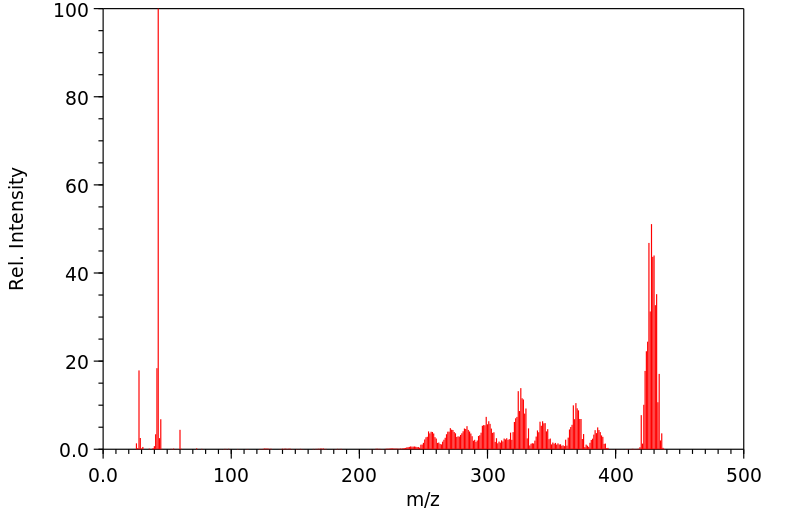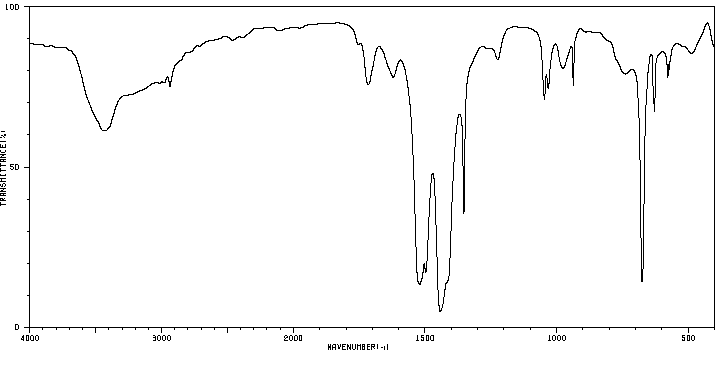乙酸钼(II)二聚体 | 14221-06-8
中文名称
乙酸钼(II)二聚体
中文别名
乙酸钼;乙酸钼二聚体
英文名称
tetrakis(acetato)dimolybdenum(II)
英文别名
Mo2(OAc)4;dimolybdenum tetraacetate;molybdenum(II) acetate;molybdenum acetate;dimolybdenum tetrakis(μ-acetate);molybdenum(II) acetate dimer;Molybdenum, tetrakis[mu-(acetato-O:O')]di-, (Mo-Mo);molybdenum(2+);tetraacetate
CAS
14221-06-8
化学式
C8H12Mo2O8
mdl
——
分子量
428.058
InChiKey
DOOLFANBWPPEGQ-UHFFFAOYSA-J
BEILSTEIN
——
EINECS
——
-
物化性质
-
计算性质
-
ADMET
-
安全信息
-
SDS
-
制备方法与用途
-
上下游信息
-
文献信息
-
表征谱图
-
同类化合物
-
相关功能分类
-
相关结构分类
物化性质
-
暴露限值:ACGIH: TWA 0.5 mg/m3; TWA 10 mg/m3; TWA 3 mg/m3NIOSH: IDLH 1000 mg/m3; IDLH 5000 mg/m3
-
稳定性/保质期:
计算性质
-
辛醇/水分配系数(LogP):-4.98
-
重原子数:18
-
可旋转键数:0
-
环数:0.0
-
sp3杂化的碳原子比例:0.5
-
拓扑面积:161
-
氢给体数:0
-
氢受体数:8
安全信息
-
安全说明:S24/25
-
WGK Germany:3
-
海关编码:2915900090
-
储存条件:常温下应密闭避光保存,并置于通风干燥处。
SDS
Section 1: Product Identification
Chemical Name: Molybdenum (II) acetate dimer,99%
CAS Registry Number: 14221-06-8
Formula: Mo2(OOCCH3)4
EINECS Number: 238-089-5
Chemical Family: metal acetate salt
Synonym: Molybdenum diacetate
Section 2: Composition and Information on Ingredients
Ingredient CAS Number Percent ACGIH (TWA) OSHA (PEL)
Title Compound 14221-06-8 100% 10mg/m3 (as Mo - 15mg/m3
Section 3: Hazards Identification
Emergency Overview: Irritating to eyes and skin. May be harmful if swallowed or inhaled.
Primary Routes of Exposure: Ingestion
Eye Contact: Causes mild irritation of the eyes.
Skin Contact: Causes slight irritation of the skin.
Inhalation: Inhalation of dust may lead to irritation of the respiratory tract.
Ingestion: No information is available on the physiological effects of ingestion. May be harmful if swallowed.
Acute Health Affects: Irritating to eyes and skin. May be harmful if swallowed or inhaled.
Chronic Health Affects: No information available on long-term chronic effects.
NTP: No
IARC: No
OSHA: No
SECTION 4: First Aid Measures
Immediately flush the eyes with copious amounts of water for at least 10-15 minutes. A victim may need
Eye Exposure:
assistance in keeping their eye lids open. Get immediate medical attention.
Wash the affected area with water. Remove contaminated clothes if necessary. Seek medical assistance if
Skin Exposure:
irritation persists.
Remove the victim to fresh air. Closely monitor the victim for signs of respiratory problems, such as difficulty
Inhalation:
in breathing, coughing, wheezing, or pain. In such cases seek immediate medical assistance.
Seek medical attention immediately. Keep the victim calm. Give the victim water (only if conscious). Induce
Ingestion:
vomiting only if directed by medical personnel.
SECTION 5: Fire Fighting Measures
Flash Point: not applicable
Autoignition Temperature: none
Explosion Limits: none
Extinguishing Medium: carbon dioxide, dry powder or foam
If involved in a fire, fire fighters should be equipped with a NIOSH approved positive pressure self-contained
Special Fire Fighting Procedures:
breathing apparatus and full protective clothing.
Hazardous Combustion and If involved in a fire this material may emit toxic organic fumes.
Decomposion Products:
Unusual Fire or Explosion Hazards: No unusual fire or explosion hazards.
SECTION 6: Accidental Release Measures
Spill and Leak Procedures: Small spills can be mixed with vermiculite or sodium carbonate and swept up.
SECTION 7: Handling and Storage
Handling and Storage:
SECTION 8: Exposure Controls and Personal Protection
Eye Protection: Always wear approved safety glasses when handling a chemical substance in the laboratory.
Skin Protection: Wear protective clothing and gloves.
Ventilation: Material may form a fine dust. If possible, handle the material in an efficient fume hood.
If ventilation is not available a respirator should be worn. The use of respirators requires a Respirator
Respirator:
Protection Program to be in compliance with 29 CFR 1910.134.
Ventilation: Material may form a fine dust. If possible, handle the material in an efficient fume hood.
Additional Protection: No additional protection required.
SECTION 9: Physical and Chemical Properties
Color and Form: yellow xtl.
Molecular Weight: 428.06
Melting Point: no data
Boiling Point: no data
Vapor Pressure: not applicable
Specific Gravity: no data
Odor: none
Solubility in Water: insoluble
SECTION 10: Stability and Reactivity
Stability: air sensitive, (store cold)
Hazardous Polymerization: no hazardous polymerization
Conditions to Avoid: prolonged exposure to air
Incompatibility: oxidizing agents
Decomposition Products: carbon dioxide, carbon monoxide, organic fumes, and molybdenum salts.
SECTION 11: Toxicological Information
RTECS Data: No information available in the RTECS files.
Carcinogenic Effects: No data available
Mutagenic Effects: No data available
Tetratogenic Effects: No data available
SECTION 12: Ecological Information
Ecological Information: No information available
SECTION 13: Disposal Considerations
Disposal: Dispose of according to local, state and federal regulations.
SECTION 14: Transportation
Shipping Name (CFR): Non-hazardous
Hazard Class (CFR): NA
Additional Hazard Class (CFR): NA
Packaging Group (CFR): NA
UN ID Number (CFR): NA
Shipping Name (IATA): Non-hazardous
Hazard Class (IATA): NA
Additional Hazard Class (IATA): NA
Packaging Group (IATA): NA
UN ID Number (IATA): NA
SECTION 15: Regulatory Information
TSCA: Not listed in the TSCA inventory.
SARA (Title 313): Not reportable under SARA Title 313.
Second Ingredient: none
SECTION 16 - ADDITIONAL INFORMATION
N/A
制备方法与用途
反应信息
-
作为反应物:描述:乙酸钼(II)二聚体 在 triphenylphosphine 、 cyclopentadienyl sodium 、 hydrochloric acid 作用下, 以 四氢呋喃 、 水 为溶剂, 以43%的产率得到二氯二茂钼参考文献:名称:钼烯二聚体化学中的相互关系:双-η-环戊二烯基二氯钼的便捷合成摘要:二聚体[ η -C 5 ħ 5)2 HMO { μ - (η 1:η 5 -C 5 H ^ 4)}的Mo(η -C 5 ħ 5)]和[(η -C 5 ħ 5)(CO )钼μ - (η 5:η 1 -C 5 ħ 4)的Mo(Co)的2(η -C 5 ħ 5 ]已从[沫制备2(O 2CMe)4 ]并通过晶体结构测定来表征;前者的二聚物容易与盐酸水溶液反应生成二氯单体[Mo(η- C 5 H 5)2 Cl 2 ]。DOI:10.1039/c39820000030
-
作为产物:描述:参考文献:名称:Preparation of [Mo2(O2CCH3)4] and [CrMo(O2CCH3)4] from MII derivatives (M = Cr, Mo)摘要:DOI:10.1016/s0277-5387(00)86902-8
-
作为试剂:描述:参考文献:名称:REGIOSPECIFIC RING CLEAVAGE OF α,β-EPOXYSILANES TO FORM TRANSITION METAL ENOLATE INTERMEDIATES摘要:二乙酸钼(II)二聚体或四(iv)异丙氧化钛诱导了α,β-环氧硅烷的区域选择性环开裂,形成醇盐中间体,随后与醛反应生成相应的α,β-不饱和羰基化合物。DOI:10.1246/cl.1984.367
文献信息
-
Studies on transition-metal cyano-complexes. Part 3. Heptacyano-complexes of tungsten, molybdenum, and vanadium, and a hydrido-heptacyano-complex of tungsten作者:Ana-Maria Soares、William P. GriffithDOI:10.1039/dt9810001886日期:——The new complexes K5[W(CN)7]·H2O and K4[WH(CN)7]·2H2O are reported, and have been characterised by 1H, 13C n.m.r., and vibrational spectra. Vibrational and e.s.r. data are also presented for the new salt NaK3[Mo(CN)7]·2H2O and earlier data are extended for K4[Mo(CN)7]·2H2O and K4[V(CN)7]·2H2O.报道了新的配合物K 5 [W(CN)7 ]·H 2 O和K 4 [WH(CN)7 ]·2H 2 O,并通过1 H,13 C nmr和振动光谱对其进行了表征。还提供了新盐NaK 3 [Mo(CN)7 ]·2H 2 O的振动数据和esr数据,并扩展了K 4 [Mo(CN)7 ]·2H 2 O和K 4 [V(CN )的早期数据。)7 ]·2H 2 O.
-
Organometallic chemistry in a conventional microwave oven: the facile synthesis of group 6 carbonyl complexes作者:Michael Ardon、Graeme Hogarth、Daniel T.W OscroftDOI:10.1016/j.jorganchem.2004.04.030日期:2004.8however, this reaction requires an inert atmosphere. While W(CO)6 reacts rapidly with amines to give cis diamine adducts in high yields, direct reactions with phosphines are not so clean. Bis(phosphine) complexes are, however, cleanly formed when a small amount of piperidine is added to the reaction mixture, presumably via the bis(piperidine) complex cis-[W(CO)4(pip)2]. Reactions with Cr(CO)6 generally通过在改进的常规微波炉中进行反应,可以改善,加速和简化通过回流进行的合成。为了证明这种方法的潜力,据报道合成了20多种第6组有机金属化合物。六羰基,最著名的是Mo(CO)6,在改良的常规微波炉中与一定范围的单,双和三齿配体反应。它们通常在没有惰性气氛的情况下进行,产率高且反应时间短。例如,在20分钟内以大于95%的收率制备顺式[[Mo(CO)4(dppe)]。Mo(CO)6与二环戊二烯的反应可简单地一步合成[CpMo(CO)3 ]。2个在> 90%的产率,这与在甲苯中的炔烃以产生dimetallatetrahedrane衍生物进一步反应,混合[Cp 2沫2(CO)4(μ-RC 2 R)]; 大概是通过原位形成对空气敏感的[CpMo(CO)2 ] 2来实现的。还可以在45分钟内以48%的收率制备四乙酸二钼酸乙酯,但是,该反应需要惰性气氛。W(CO)6与胺快速反应以高产率生成顺式二胺加合物,但
-
How to Make a Major Shift in a Redox Potential: Ligand Control of the Oxidation State of Dimolybdenum Units作者:F. Albert Cotton、Lee M. Daniels、Chun Y. Liu、Carlos A. Murillo、Arthur J. Schultz、Xiaoping WangDOI:10.1021/ic025632w日期:2002.8.1(Bu(n)()(4)N)(2)H(2)[Mo(2)[Mo(CO)(4)(PhPO(2))(2)](2)] has been reexamined. We find that the hydrogen atoms in this formula are not present. Therefore, the complex must be considered as having a central triply bonded Mo(2)(6+) unit, instead of a quadruply bonded Mo(2)(4+) unit. Our conclusion is based on a variety of experimental evidence, including X-ray crystal structures of four crystal forms, as well早先(Polyhedron 1989,8,2339)报道为(Bu(n)()(4)N)(2)H(2)[Mo(2)[Mo(CO)(4)(PhPO(2)) )(2)](2)]已重新检查。我们发现该式中的氢原子不存在。因此,该复合物必须被视为具有中央三键式Mo(2)(6+)单元,而不是四键式Mo(2)(4+)单元。我们的结论基于各种实验证据,包括四种晶形的X射线晶体结构以及一种晶形的中子晶体结构。这就解释了在2.1874(7)-2.2225(7)A范围内发现的相对较长的Mo-Mo键长度以及可见光谱中不存在delta-> delta跃迁的现象。从电化学中我们还发现,二膦酸酯配体具有稳定较高氧化态的出色能力,即使是普通溶剂(例如CH(2)Cl(2)和C(2)H(5)OH)也容易氧化Mo(2)从Mo(2)(O(2)CCH(3))(4)或[Mo(2)(O(2)CCH(3))(2)(NCCH(3) ))(6
-
Lewis Acid Enhanced Axial Ligation of [Mo<sub>2</sub>]<sup>4+</sup> Complexes作者:Brian S. Dolinar、John F. BerryDOI:10.1021/ic400275x日期:2013.4.15syntheses, X-ray crystal structures, electrochemistry, and density functional theory (DFT) single-point calculations of three new complexes: tetrakis(monothiosuccinimidato)dimolybdenum(II) [Mo2(SNO5)4, 1a], tetrakis(6-thioxo-2-piperidinonato)dimolybdenum(II) [Mo2(SNO6)4, 1b], and chlorotetrakis(monothiosuccinimidato)pyridinelithiumdimolybdenum(II) [pyLiMo2(SNO5)4Cl, 2-py]. X-ray crystallography shows unusually我们在这里报告的三个新的复合物的合成,X射线晶体结构,电化学,和密度泛函理论(DFT)的单点计算:四(monothiosuccinimidato)dimolybdenum(II)[沫2(SNO5)4,1A ],四(6-硫代-2- piperidinonato)dimolybdenum(II)[沫2(SNO6)4,1B ]和chlorotetrakis(monothiosuccinimidato)pyridinelithiumdimolybdenum(II)[pyLiMo 2(SNO5)4氯,2-PY。X射线晶体学显示2-Py,2.6533(6)Å和2-dim二聚体的轴向Mo 2 -Cl轴向键长度异常短,2.644(1)Å,我们提出是由于在近端Li +离子存在下Mo 2单元的路易斯酸度增加。当2-Py溶解在MeCN中时,锂可逆地解离,形成(MeCNLiMo 2(SNO5)4 Cl)(2-MeCN)和[Li(MeCN)4
-
Modifying Electronic Communication in Dimolybdenum Units by Linkage Isomers of Bridged Oxamidate Dianions作者:F. Albert Cotton、Chun Y. Liu、Carlos A. Murillo、Dino Villagrán、Xiaoping WangDOI:10.1021/ja036884e日期:2003.11.1bridged by the oxamidate anions. For the alpha isomers, the C-C unit of the dianion is nearly perpendicular to the Mo-Mo bonds, and these are essentially perpendicular to each other. For the beta isomers, the corresponding C-C unit and the Mo-Mo bonds are essentially parallel to each other. Each type of isomer is stable in solution. The electronic communication as measured by the DeltaE(1/2) for the oxidationMo(2)(O(2)CCH(3))(DAniF)(3), DAniF = N,N'-di-p-anisylformamidinate, 与草酰胺二价阴离子 [ArNC(O)C(O)NAr] 的反应(2-), Ar = C(6)H(5) 和对茴香基,给出一对异构化合物,其中 [Mo(2)] 单元由草酰胺阴离子桥接。对于 α 异构体,二价阴离子的 CC 单元几乎垂直于 Mo-Mo 键,并且它们基本上彼此垂直。对于β异构体,相应的CC单元和Mo-Mo键基本上相互平行。每种类型的异构体在溶液中都是稳定的。由 DeltaE(1/2) 测量的每个 Mo(2) 单元氧化的电子通信对于 beta 异构体来说明显更好。在β异构体而不是α异构体氧化时,在近红外区域出现通常称为间隔电荷转移带的现象也支持了这一点。分子力学和 DFT 计算有助于解释 alpha 异构体的相对构象以及 alpha 和 beta 异构体之间的相对能量差异。
表征谱图
-
氢谱1HNMR
-
质谱MS
-
碳谱13CNMR
-
红外IR
-
拉曼Raman
-
峰位数据
-
峰位匹配
-
表征信息
同类化合物
(甲基3-(二甲基氨基)-2-苯基-2H-azirene-2-羧酸乙酯)
(±)-盐酸氯吡格雷
(±)-丙酰肉碱氯化物
(d(CH2)51,Tyr(Me)2,Arg8)-血管加压素
(S)-(+)-α-氨基-4-羧基-2-甲基苯乙酸
(S)-阿拉考特盐酸盐
(S)-赖诺普利-d5钠
(S)-2-氨基-5-氧代己酸,氢溴酸盐
(S)-2-[[[(1R,2R)-2-[[[3,5-双(叔丁基)-2-羟基苯基]亚甲基]氨基]环己基]硫脲基]-N-苄基-N,3,3-三甲基丁酰胺
(S)-2-[3-[(1R,2R)-2-(二丙基氨基)环己基]硫脲基]-N-异丙基-3,3-二甲基丁酰胺
(S)-1-(4-氨基氧基乙酰胺基苄基)乙二胺四乙酸
(S)-1-[N-[3-苯基-1-[(苯基甲氧基)羰基]丙基]-L-丙氨酰基]-L-脯氨酸
(R)-乙基N-甲酰基-N-(1-苯乙基)甘氨酸
(R)-丙酰肉碱-d3氯化物
(R)-4-N-Cbz-哌嗪-2-甲酸甲酯
(R)-3-氨基-2-苄基丙酸盐酸盐
(R)-1-(3-溴-2-甲基-1-氧丙基)-L-脯氨酸
(N-[(苄氧基)羰基]丙氨酰-N〜5〜-(diaminomethylidene)鸟氨酸)
(6-氯-2-吲哚基甲基)乙酰氨基丙二酸二乙酯
(4R)-N-亚硝基噻唑烷-4-羧酸
(3R)-1-噻-4-氮杂螺[4.4]壬烷-3-羧酸
(3-硝基-1H-1,2,4-三唑-1-基)乙酸乙酯
(2S,4R)-Boc-4-环己基-吡咯烷-2-羧酸
(2S,3S,5S)-2-氨基-3-羟基-1,6-二苯己烷-5-N-氨基甲酰基-L-缬氨酸
(2S,3S)-3-((S)-1-((1-(4-氟苯基)-1H-1,2,3-三唑-4-基)-甲基氨基)-1-氧-3-(噻唑-4-基)丙-2-基氨基甲酰基)-环氧乙烷-2-羧酸
(2S)-2,6-二氨基-N-[4-(5-氟-1,3-苯并噻唑-2-基)-2-甲基苯基]己酰胺二盐酸盐
(2S)-2-氨基-N,3,3-三甲基-N-(苯甲基)丁酰胺
(2S)-2-氨基-3-甲基-N-2-吡啶基丁酰胺
(2S)-2-氨基-3,3-二甲基-N-(苯基甲基)丁酰胺,
(2S)-2-氨基-3,3-二甲基-N-2-吡啶基丁酰胺
(2S,4R)-1-((S)-2-氨基-3,3-二甲基丁酰基)-4-羟基-N-(4-(4-甲基噻唑-5-基)苄基)吡咯烷-2-甲酰胺盐酸盐
(2R,3'S)苯那普利叔丁基酯d5
(2R)-2-氨基-3,3-二甲基-N-(苯甲基)丁酰胺
(2-氯丙烯基)草酰氯
(1S,3S,5S)-2-Boc-2-氮杂双环[3.1.0]己烷-3-羧酸
(1R,5R,6R)-5-(1-乙基丙氧基)-7-氧杂双环[4.1.0]庚-3-烯-3-羧酸乙基酯
(1R,4R,5S,6R)-4-氨基-2-氧杂双环[3.1.0]己烷-4,6-二羧酸
齐特巴坦
齐德巴坦钠盐
齐墩果-12-烯-28-酸,2,3-二羟基-,苯基甲基酯,(2a,3a)-
齐墩果-12-烯-28-酸,2,3-二羟基-,羧基甲基酯,(2a,3b)-(9CI)
黄酮-8-乙酸二甲氨基乙基酯
黄荧菌素
黄体生成激素释放激素(1-6)
黄体生成激素释放激素 (1-5) 酰肼
黄体瑞林
麦醇溶蛋白
麦角硫因
麦芽聚糖六乙酸酯
麦根酸








